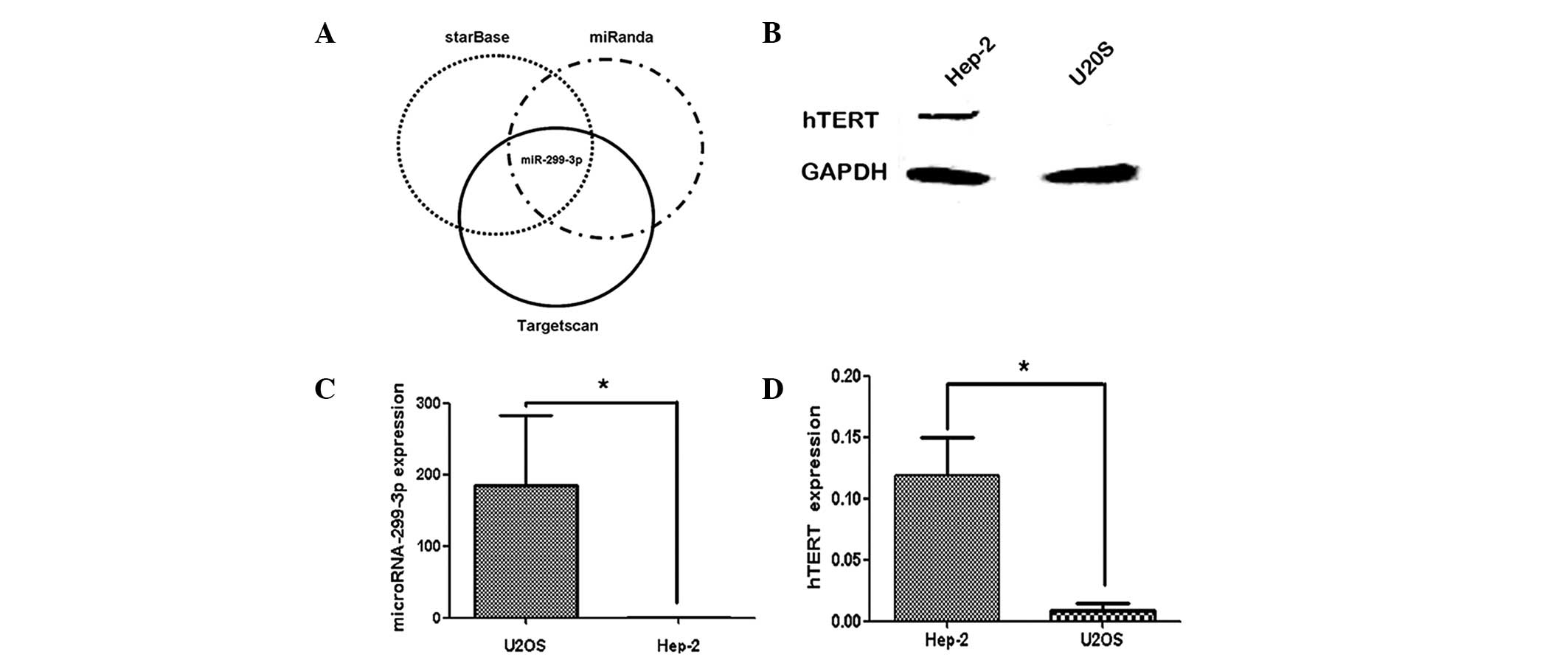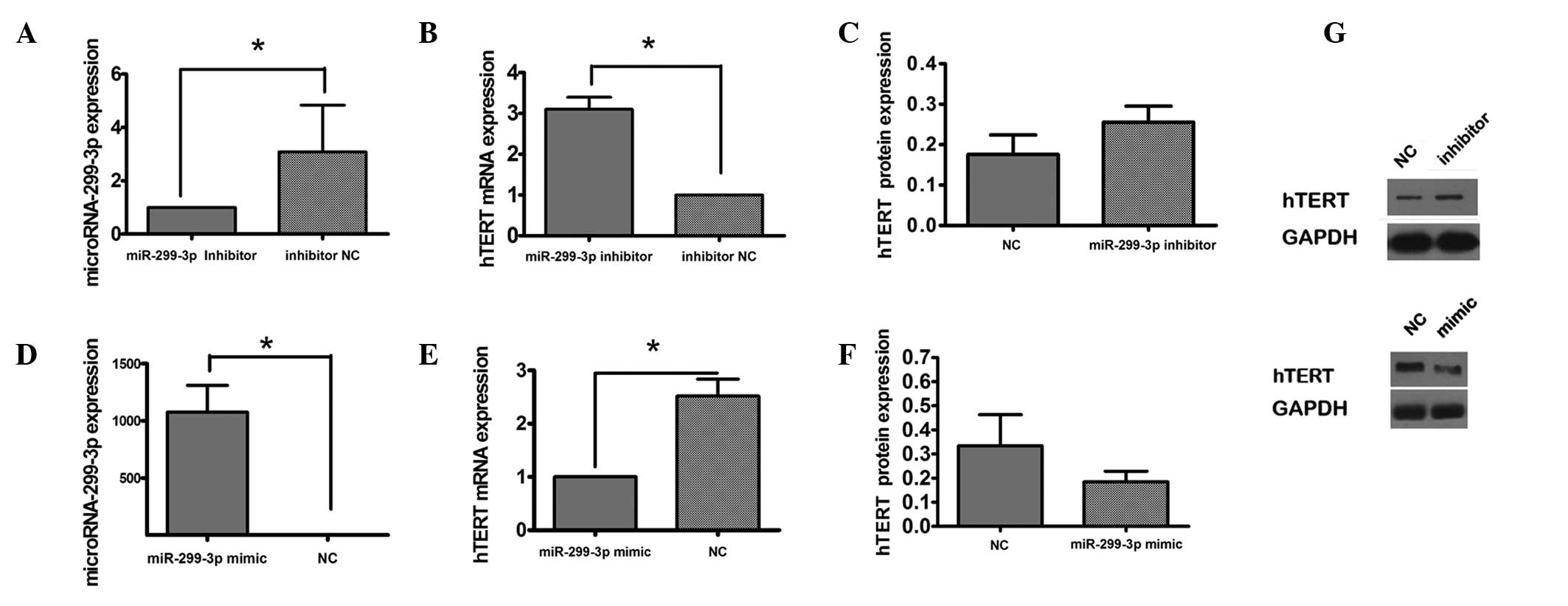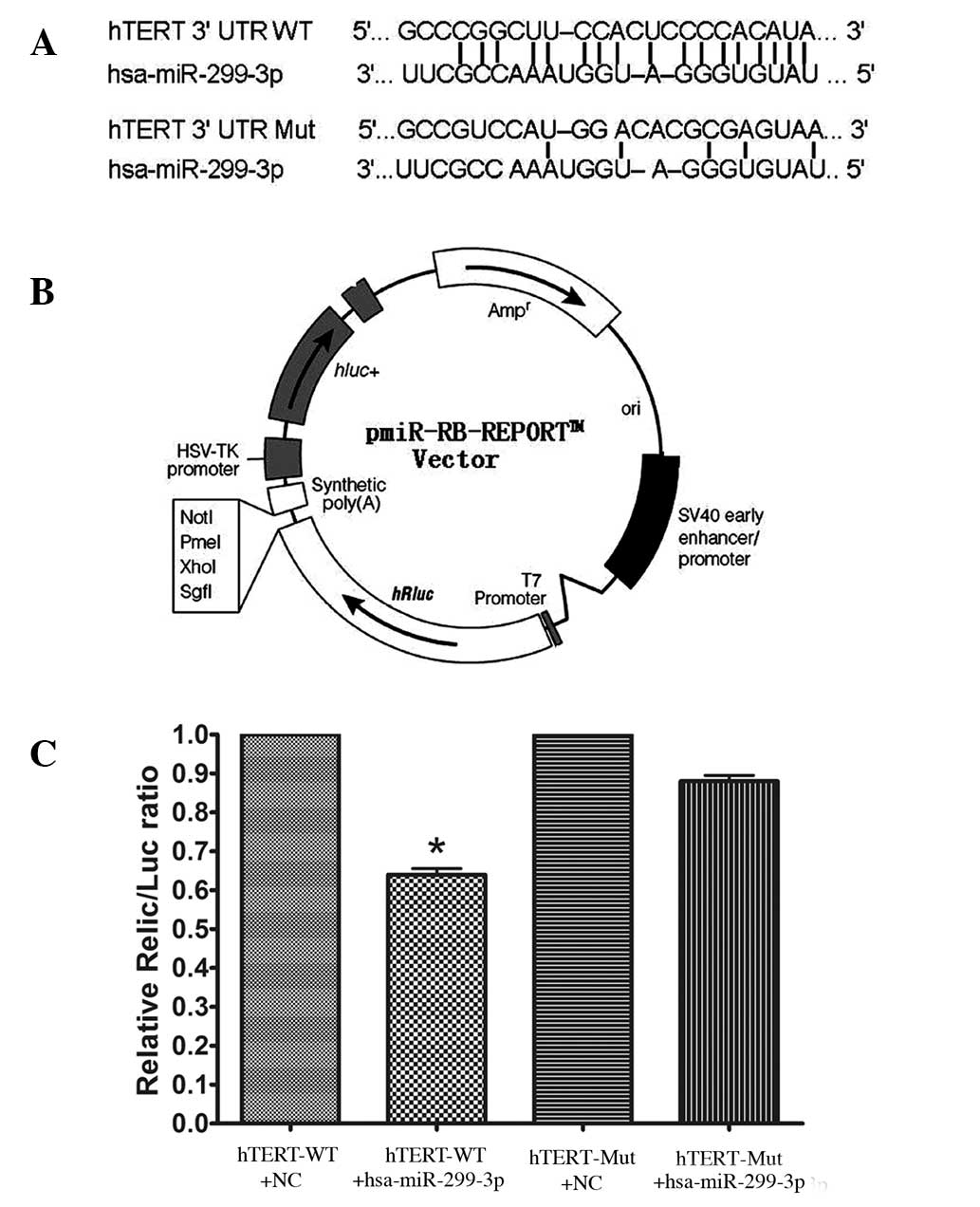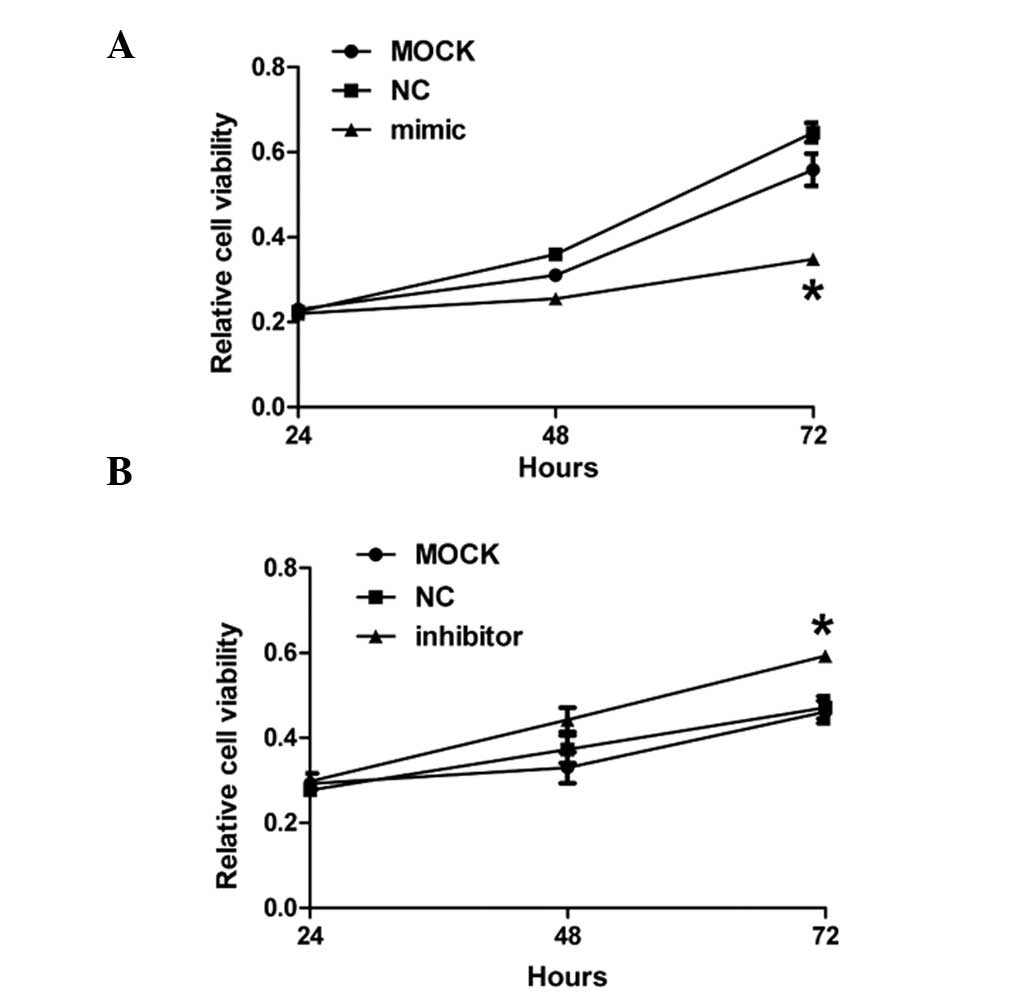microRNA‑299‑3p inhibits laryngeal cancer cell growth by targeting human telomerase reverse transcriptase mRNA
- Authors:
- Published online on: January 30, 2015 https://doi.org/10.3892/mmr.2015.3287
- Pages: 4645-4649
Abstract
Introduction
MicroRNAs (miRNAs), a class of highly conserved small non-coding RNAs, play crucial roles in regulating the expression of target genes in a sequence-specific manner (1,2). It is acknowledged that the binding of a specific miRNA to the 3′-untranslated region (3′-UTR) of target mRNA may inhibit the expression of target genes. To date, several classes of miRNAs have been reported to play significant regulatory roles in various cellular processes through translational repression, including cell proliferation, apoptosis and developmental timing (3). Previous studies have revealed that aberrant expression of miRNA is associated with the development of human cancer, and its expression profiling has been identified as a signature of the diagnostic and prognostic characteristics of specific carcinomas (4,5). Li et al demonstrated that down-regulation of miR-1297 in Hep-2 cells may inhibit proliferation of cancer cells, migration and tumor genesis in vitro (6). Simultaneously, these authors discovered that miR-1297 may be directly involved in the downregulation of phosphatase and tensin homolog in Hep-2-cells and solid tumors. Moreover, Wu et al demonstrated that overexpression of miR-16 contributed to the cell migration of Hep-2 laryngeal cancer cells and suppression of intercellular adhesion. Additionally, zyxin, which was negatively regulated by miR-16, was confirmed to be a direct target gene of miR-16 (7). On this basis, we predicted that miRNA-mediated regulation of cellular and genetic expression may be an appropriate treatment option for malignant tumors.
Human telomerase reverse transcriptase (hTERT), a catalytic subunit of telomerase, is considered to be the most significant component of the telomerase complex together with the telomerase RNA component (8,9). Telomerase activity is crucial in the immortality of cancer cells (e.g. Hep-2 cancer cells) through continuously adding the telomeric repeats onto the G-overhang of the 3′ termini of telomeres (10). Research reveals that only one study has investigated the correlation between the expression of miRNA and hTERT (11), in which miR-138 induced a reduction in hTERT protein in human anaplastic thyroid carcinoma cell lines. Therefore, it is still unclear which of the miRNAs could exert a strong suppressive effect on the expression of hTERT in cancer cells.
In the present study, hTERT expression was found to be inversely correlated with the endogenous expression of miR-299-3p in Hep-2 and U2OS cells; moreover, overexpression of miR-299-3p inhibited the expression of hTERT mRNA and protein by directly targeting the 3′-UTR of hTERT mRNA. Furthermore, downregulation of hTERT mediated by miR-299-3p mimic inhibited Hep-2 cell growth. The results of this study may be of use in the treatment of human laryngeal cancer.
Materials and methods
Cell culture and transfection
Hep-2 cells and U2OS cells were obtained from the Cell Bank of Type Culture Collection of the Chinese Academy of Science (Shanghai, China). The cells were maintained in Dulbecco’s modified Eagle’s medium (Sigma-Aldrich, St. Louis, MO, USA) containing 10% fetal bovine serum (Sigma-Aldrich) at 37°C in 5% CO2 at a humidity of 95%. Transfection of Hep-2 cells was performed with Lipofectamine 2000 (Invitrogen Life Technologies, Carlsbad, CA, USA) following the manufacturer’s instructions. Transfections were performed in triplicate for each experiment.
Prediction of miRNAs targeting hTERT
To predict the miRNAs that target hTERT and the conserved sites bound by the seed region of these miRNAs, different target prediction programs were used, including TargetScan (http://www.targetscan.org/), miRanda (http://www.microrna.org/microrna/home.do) and starBase(http://starbase.sysu.edu.cn/).
Quantitative polymerase chain reaction (qPCR)
Total RNA was extracted from Hep-2 cells or U2OS cells using TRIzol reagent (Invitrogen Life Technologies), strictly following the instructions. The synthesis of cDNA was carried out using the RevertAid First strand cDNA synthesis kit (Fermentas; Thermo Fisher Scientific, Waltham, MA, USA). qPCR was performed using TaqMan miRNA assay kits (Applied Biosystems, Foster City, CA, USA) on an Applied Biosystems 7500 thermal cycler. The expression of miRNA was normalized using glyceraldehyde 3-phosphate dehydrogenase (GAPDH). The primers for hTERT were 5′-CTTCCACTCCCCACATAGGA-3′ (hTERT-F) and 5′-GTA CAGGGCACACCTTTGGT-3′ (hTERT-R). The primers for GAPDH were 5′-AGAAGGCTGGGGCTCATTTG-3′ (GAPDH-F) and 5′-AGGGGCCATCCACAGTCTTC-3′ (GAPDH-R). PCR amplification was conducted in a volume of 20 μl containing 3 μl RT product, 10 μl 1X SYBR Select master mix and 7 μl all-in-one miRNA qPCR primer. The reaction conditions were as follows: 50°C for 2 min and 95°C for 20 sec, followed by 40 cycles of 95°C for 10 sec, 60°C for 34 sec and 70°C for 10 sec. Melting analysis was carried out at the end of the amplification cycle to verify non-specific amplification. The expression level was quantified using the 2−ΔΔCt method.
Construction of luciferase reporter plasmids and luciferase assays
The 3′-UTR segments of hTERT containing the miR-299-3p binding sites were amplified by PCR from Hela cell genomic DNA. The primers were 5′-CCGCTCGAGTGGCCACCCGCCCACAG-3′ (hTERT-F) and 5′-GTTTAGCGGCCGCTTTTACTCCCACAGCACCTCC-3′ (hTERT-R). Next, the PCR product was cloned into the XhoI/NotI sites downstream of the Renilla luciferase (Rluc) reporter gene pmiR-RB-Report™ vector (RiboBio, Guangzhou, China), which was named pmiR-hTERT-3′-UTR-wt. Mutations in the predicted miR-299-3p binding sites were established using pmiR-hTERT-3′-UTR-wt as a template, and was named pmiR-hTERT-3′-UTR-mut. The pmiR-RB-Report vector containing a synthetic Renilla luciferase (hRluc) gene and a synthetic firefly luciferase (hluc) gene encoding firefly luciferase was used as the internal control. The recombinant plasmid, designated as pmiR-RB-hTERT-3′-UTR, was confirmed by restriction enzyme digestion and DNA sequencing. Hela cells were co-transfected in 96-well plates with miR-299-3p mimic or negative control (RiboBio), pmiR-hTERT-3′-UTR-wt or pmiR-hTERT-3′-UTR-mut by Lipofectamine 2000. Forty-eight hours after transfection, luciferase activity was measured using the dual luciferase assay system (Promega, Heidelberg, Germany). The firefly luciferase activity of each sample was normalized to Renilla luciferase activity.
Western blot analysis
Western blot analysis was performed as routinely described. Briefly, the protein was homogenized in modified RIPA buffer containing 0.5% sodium dodecyl sulfate (SDS) in the presence of proteinase inhibitor cocktail (Complete mini; Roche Diagnostics, Basel, Switzerland). Proteins (40 μg) were separated by electrophoresis on a 10% SDS-PAGE gel and transferred to a PVDF membrane (Millipore, Billerica, MA, USA). Subsequently, the membrane was blocked in 5% non-fat milk and incubated with rabbit anti-hTERT antibody (1:1000 dilution; Epitomics, Burlingame, CA, USA) at 4°C overnight, followed by incubation with a secondary antibody (1:5000; LI-COR, Lincoln, NE, USA) for 4 h at room temperature. The same membrane was probed for GAPDH (1:1000 dilution; Epitomics) as the loading control. The relative density of hTERT to GAPDH was analyzed with an Odyssey® infrared imaging system (LI-COR).
CCK-8 assay
Hep-2 Cells were seeded in a 96-well plate at a concentration of 103 cells per well. Following transfection, the cells were maintained at 37°C for 24, 48 and 72 h, respectively. The cells were treated with CCK-8 (Dojindo Inc., Kunamoto, Japan) for 4 h at 37°C. Subsequently, the medium was removed and the pellet was dissolved in 100 μl DMSO. Finally, the number of cells was determined using a microplate reader at a wavelength of 450 nm.
Statistical analysis
SPSS 11.5 software (SPSS Inc., Chicago, IL, USA) was used for the data analysis. Student’s t-test was performed to analyze the differences between the data obtained from three independent experiments. P<0.05 was considered to indicate a statistically significant difference.
Results
hTERT expression is inversely correlated with endogenous expression of miR-299-3p in Hep-2 and U2OS cells
Fig. 1 shows the correlation between miR-299-3p expression and hTERT protein in Hep-2 and U2OS cells. Western blot analysis revealed that hTERT was positively expressed in the Hep-2 cells, while it was negatively expressed in U2OS cells (Fig. 1B). In addition, qPCR was used to measure the expression of miR-299-3p in the two cell lines. As shown in Fig. 1C, higher levels of miR-299-3p were observed in U2OS cell lines compared with those in Hep-2 cells. An inverse correlation was observed between the expression of miR-299-3p and hTERT protein in these two cell lines. These results indicated that the high expression of hTERT in Hep-2 cell lines was inversely correlated with the endogenous expression of miR-299-3p.
miR-299-3p regulates the expression of hTERT in Hep-2 cells
To investigate the association between miR-299-3p and hTERT, the expression of hTERT was measured following knockdown of miR-299-3p in vitro (Fig. 2A). RT-qPCR analysis demonstrated that transfection of Hep-2 cells with miR-299-3p inhibitor contributed to the expression of hTERT mRNA compared with the control group transfected with a scrambled inhibitor negative control (Fig. 2B). In addition, the expression of hTERT protein was increased in the presence of miR-299-3p downregulation (Fig. 2C). The effect of overexpression of miR-299-3p induced by miR-299-3p mimic on the expression of hTERT protein was investigated by RT-qPCR and western blot analysis (Fig. 2D–F). It was observed that upregulation of miR-299-3p reduced the expression of hTERT mRNA and protein. These results indicated that miR-299-3p negatively regulated hTERT expression.
hTERT is a direct target of miR-299-3p
In Hela cells co-transfected with the reporter plasmids and miR-299-3p mimic or negative control duplex, the activity of the luciferase reporter containing wild-type 3′-UTR was significantly suppressed by miR-299-3p mimic. To be precise, the luciferase activity declined by 36% in comparison with the negative control (P<0.05). However, the luciferase activity of the mutant reporter recovered by 24% compared with the wild type, indicating that miR-299-3p may suppress the expression of hTERT by binding with the 3′-UTR of hTERT mRNA. Together, the results revealed that miR-299-3p regulated the expression of endogenous human hTERT by directly targeting the 3′-UTR of hTERT mRNA (as shown in Fig. 3).
miR-299-3p affects the growth of Hep-2 cancer cells
To investigate the effects of miR-299-3p overexpression on the growth of Hep-2 cancer cells, CCK-8 assay was performed on Hep-2 cells 24, 48 and 72 h after treatment with miR-299-3p mimic, inhibitor and negative control, respectively. As demonstrated in Fig. 4A, the growth of Hep-2 cancer cells notably decreased 72 h after transfection of miR-299-3p mimic compared with the mock and negative control. However, downregulation of miR-299-3p contributed to a significant increase in cell growth compared with the other two groups 72 h after transfection with miR-299-3p inhibitor. All of these results demonstrated that miR-299-3p affected the growth of Hep-2 cancer cells.
Discussion
Our study firstly demonstrated that miR-299-3p may significantly downregulate the expression of hTERT in human Hep-2 cells. Compared with the hTERT-negative U2OS cells, overexpression of miR-299-3p was noted in hTERT-positive Hep-2 cells. Thus, miR-299-3p may act as a tumor suppressor in Hep-2 cancer cells.
As the core catalytic subunit of the enzyme telomerase, hTERT protein has a significant effect on tumorigenesis. Previous studies have shown that telomerase is activated at various levels, including the transcriptional and post-transcriptional levels of hTERT (8,12). In addition, a positive correlation has been reported between hTERT expression and telomerase activity in a variety of cancer cell lines (13,14). To our knowledge, several protein kinases were involved in the post-transcriptional modification of hTERT protein; for instance, AKT kinase and protein kinase C have been reported to mediate the phosphorylation of hTERT protein, leading to activation of telomerase activity (15,16). In addition, certain accessory proteins (e.g. 14-3-3 protein and nuclear factor-κB) may modulate telomerase activity by interacting with hTERT protein (17,18). miRNA has always been considered to be one of the key factors in the post-transcriptional mechanism. However, few studies have noted the suppressive effects of miRNA on hTERT expression (11). To identify a miRNA that can directly target hTERT in human laryngeal cancer, we examined the expression of miR-299-3p and its effects on hTERT in human Hep-2 laryngeal cancer cells.
Computational algorithms reveal that miR-299-3p may directly target the binding site within the 3′-UTR of hTERT through base pairing, as it revealed high complementarity to the 3′-UTR of hTERT mRNA. To confirm that hTERT was a target of miR-299-3p, we cloned the hTERT 3′-UTR containing the target sequence, or a fragment with several mutations in the target site, into a luciferase reporter vector, respectively. Our results demonstrated that miR-299-3p suppressed the luciferase activity of pmiR-hTERT-3′-UTR-wt by 36% compared with the negative control. The suppressive effect was blocked when treating with the vector integrated with mutation of the miR-299-3p binding sites. Moreover, the expression of endogenous hTERT mRNA and protein decreased in miR-299-3p mimic-transfected Hep-2 cells, suggesting that miR-299-3p may regulate hTERT expression by inducing mRNA degradation and translational suppression. Finally, downregulation of miR-299-3p promotes the proliferation of Hep-2 cells. All of these results demonstrate that overexpression of miR-299-3p inhibits Hep-2 cell growth by targeting the 3′-UTR of the hTERT mRNA.
Taken together, our study suggests that miR-299-3p has crucial roles in the progression of Hep-2 cancer cells by interacting with hTERT mRNA. Therefore, miR-299-3p may act as a useful diagnostic tool, and its application in gene therapy in laryngeal cancer is promising.
Acknowledgments
This study was funded by the National Natural Science Foundation of China (nos. 30901662 and 81172569) and the Science and Technology Program of Hubei Province of China (no. 302161991).
References
|
Cummins JM, He Y, Leary RJ, et al: The colorectal microRNAome. Proc Natl Acad Sci USA. 103:3687–3692. 2006. View Article : Google Scholar : PubMed/NCBI | |
|
He L and Hannon GJ: MicroRNAs: small RNAs with a big role in gene regulation. Nat Rev Genet. 5:522–531. 2004. View Article : Google Scholar : PubMed/NCBI | |
|
Felekkis K, Touvana E, Stefanou C and Deltas C: microRNAs: a newly described class of encoded molecules that play a role in health and disease. Hippokratia. 14:236–240. 2010. | |
|
Esquela-Kerscher A and Slack FJ: Oncomirs - microRNAs with a role in cancer. Nat Rev Cancer. 6:259–269. 2006. View Article : Google Scholar : PubMed/NCBI | |
|
Calin GA and Croce CM: MicroRNA signatures in human cancers. Nat Rev Cancer. 6:857–866. 2006. View Article : Google Scholar : PubMed/NCBI | |
|
Li X, Wang HL, Peng X, Zhou HF and Wang X: miR-1297 mediates PTEN expression and contributes to cell progression in LSCC. Biochem Biophys Res Commun. 427:254–260. 2012. View Article : Google Scholar : PubMed/NCBI | |
|
Wu H, Liu T, Wang R, et al: MicroRNA-16 targets zyxin and promotes cell motility in human laryngeal carcinoma cell line HEp-2. IUBMB Life. 63:101–108. 2011.PubMed/NCBI | |
|
Daniel M, Peek GW and Tollefsbol TO: Regulation of the human catalytic subunit of telomerase (hTERT). Gene. 498:135–146. 2012. View Article : Google Scholar : PubMed/NCBI | |
|
Nakano K, Watney E and McDougall JK: Telomerase activity and expression of telomerase RNA component and telomerase catalytic subunit gene in cervical cancer. Am J Pathol. 153:857–864. 1998. View Article : Google Scholar : PubMed/NCBI | |
|
Smith LL, Coller HA and Roberts JM: Telomerase modulates expression of growth-controlling genes and enhances cell proliferation. Nat Cell Biol. 5:474–479. 2003. View Article : Google Scholar : PubMed/NCBI | |
|
Mitomo S, Maesawa C, Ogasawara S, et al: Downregulation of miR-138 is associated with overexpression of human telomerase reverse transcriptase protein in human anaplastic thyroid carcinoma cell lines. Cancer Sci. 99:280–286. 2008. View Article : Google Scholar : PubMed/NCBI | |
|
Guilleret I, Yan P, Grange F, et al: Hypermethylation of the human telomerase catalytic subunit (hTERT) gene correlates with telomerase activity. Int J Cancer. 101:335–341. 2002. View Article : Google Scholar : PubMed/NCBI | |
|
Boldrini L, Faviana P, Gisfredi S, et al: Evaluation of telomerase mRNA (hTERT) in colon cancer. Int J Oncol. 21:493–497. 2002.PubMed/NCBI | |
|
Ducrest AL, Szutorisz H, Lingner J, et al: Regulation of the human telomerase reverse transcriptase gene. Oncogene. 21:541–552. 2002. View Article : Google Scholar : PubMed/NCBI | |
|
Kang SS, Kwon T, Kwon DY and Do SI: Akt protein kinase enhances human telomerase activity through phosphorylation of telomerase reverse transcriptase subunit. J Biol Chem. 274:13085–13090. 1999. View Article : Google Scholar : PubMed/NCBI | |
|
Kim YW, Hur SY, Kim TE, et al: Protein kinase C modulates telomerase activity in human cervical cancer cells. Exp Mol Med. 33:156–163. 2001. View Article : Google Scholar : PubMed/NCBI | |
|
Akiyama M, Hideshima T, Hayashi T, et al: Nuclear factor-kappaB p65 mediates tumor necrosis factor alpha-induced nuclear translocation of telomerase reverse transcriptase protein. Cancer Res. 63:18–21. 2003.PubMed/NCBI | |
|
Seimiya H, Sawada H, Muramatsu Y, et al: Involvement of proteins in nuclear localization of telomerase. EMBO J. 19:2652–2661. 2000. View Article : Google Scholar : PubMed/NCBI |













